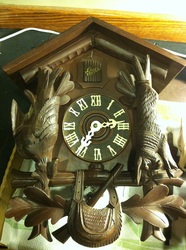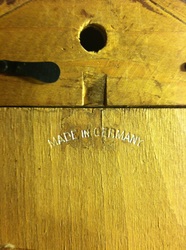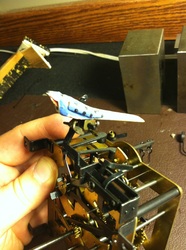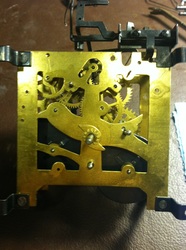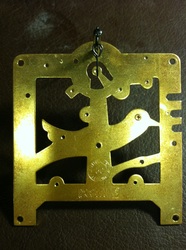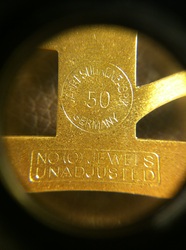Schatz Clock
400-Day Clocks

400 day dial
Summary
The company known as Schatz was first known as Jahresuhrenfabrik. The company was founded by August Schatz in the mid-1850s in the Black Forest region of Triburg, Germany. It was registered in 1881 as Schatz & Wintermantel, and was re-structured in 1884 as Jahresuhrenfabrik A.G. It was registered again in1897 as Jahresuhrenfabrik GmbH, and finally in 1923 as Jahresuhrenfabrik August Schatz & Sohne. They produced cuckoo clocks, barometers, and 400- day clocks. In later years, they produced electric clocks and battery- operated quartz clocks.
The company struggled to compete in the early 1980s, and finally closed down in 1985. (http://all_stitched_up.tripod.com/jahresuhrenfabrik.htm)
August Schatz
In the late 19th century, August Schatz was working with inventor Anton Harder, and together they formed Jahresuhrenfabrik (Year Clock Factory) with the goal of making an accurate clock that only needed winding once a year. They were successful in making the 400-day, or Anniversary, clock, but it wasn't as accurate as they'd hoped.
Harding sold his patent is 1884 to F.A..L. deGruyter of Amsterdam, and they continued to make Jahresuhrenfabrik clocks, but for some reason they allowed their patent to expire.
Other companies took up the challenge of making the 400-day clock more accurate. The pendulum for the 400-day clock was the reason it didn't need to be wound so often. A pendulum spun at the end of a suspension spring allowed it to run much longer between windings than the eight days most clocks ran. The initial designs called for a flat-disk pendulum, which then evolved into the 4-ball pendulum that is still used today.
American jewelers Bowler and Burdick marketed their 400-day clock as the Anniversary clock, and it became popular for people to wind their clock on a special yearly event like a birthday, or wedding anniversary. This also made the clocks popular gifts.
The clocks were still relatively inaccurate. Experiments were done to try to figure the best materials to make the pendulum out of, because the clocks were easily affected by humidity and temperature changes. This problem was solved when Charles Terwillinger of Horolovar Company invented the Temperature-Compensating Suspension Spring in 1951. If this thin spring wasn't tuned just right, it could throw off the best timekeeping-engineering.
Schatz Clock (2012) Shatz clock historyRetreived from: http://www.schatzclock.com/schatz-clock-company-history/
The company known as Schatz was first known as Jahresuhrenfabrik. The company was founded by August Schatz in the mid-1850s in the Black Forest region of Triburg, Germany. It was registered in 1881 as Schatz & Wintermantel, and was re-structured in 1884 as Jahresuhrenfabrik A.G. It was registered again in1897 as Jahresuhrenfabrik GmbH, and finally in 1923 as Jahresuhrenfabrik August Schatz & Sohne. They produced cuckoo clocks, barometers, and 400- day clocks. In later years, they produced electric clocks and battery- operated quartz clocks.
The company struggled to compete in the early 1980s, and finally closed down in 1985. (http://all_stitched_up.tripod.com/jahresuhrenfabrik.htm)
August Schatz
In the late 19th century, August Schatz was working with inventor Anton Harder, and together they formed Jahresuhrenfabrik (Year Clock Factory) with the goal of making an accurate clock that only needed winding once a year. They were successful in making the 400-day, or Anniversary, clock, but it wasn't as accurate as they'd hoped.
Harding sold his patent is 1884 to F.A..L. deGruyter of Amsterdam, and they continued to make Jahresuhrenfabrik clocks, but for some reason they allowed their patent to expire.
Other companies took up the challenge of making the 400-day clock more accurate. The pendulum for the 400-day clock was the reason it didn't need to be wound so often. A pendulum spun at the end of a suspension spring allowed it to run much longer between windings than the eight days most clocks ran. The initial designs called for a flat-disk pendulum, which then evolved into the 4-ball pendulum that is still used today.
American jewelers Bowler and Burdick marketed their 400-day clock as the Anniversary clock, and it became popular for people to wind their clock on a special yearly event like a birthday, or wedding anniversary. This also made the clocks popular gifts.
The clocks were still relatively inaccurate. Experiments were done to try to figure the best materials to make the pendulum out of, because the clocks were easily affected by humidity and temperature changes. This problem was solved when Charles Terwillinger of Horolovar Company invented the Temperature-Compensating Suspension Spring in 1951. If this thin spring wasn't tuned just right, it could throw off the best timekeeping-engineering.
Schatz Clock (2012) Shatz clock historyRetreived from: http://www.schatzclock.com/schatz-clock-company-history/
Cuckoo Clocks
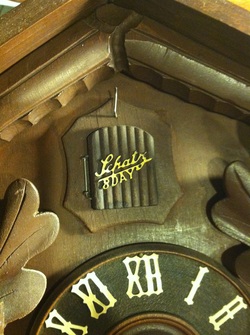
These eight-day cuckoo clocks have one of the most beautiful and clever plate designs in manufactured clocks. Both the front and back plates are cut out to reveal a bird with the eye at the third-wheel pivot hole position. The rest of the plate resembles a tree with branches. In addition, the center arbor goes through the front plate where the bird's wings would be. The strike-lifting cams provide the representation of bird wings!
Useful links:
400-day clock model http://clockhistory.com/0/model-64-1.html
400-day clock model http://clockhistory.com/0/model-71-1.html
Schatz sales brochure https://plus.google.com/photos/110693464633376032746/albums/5640839090251249329?banner=pwa
400-day clock model http://clockhistory.com/0/model-71-1.html
Schatz sales brochure https://plus.google.com/photos/110693464633376032746/albums/5640839090251249329?banner=pwa
